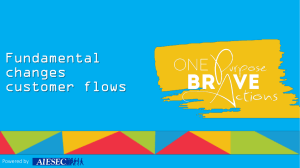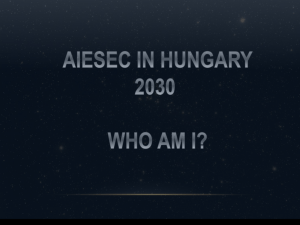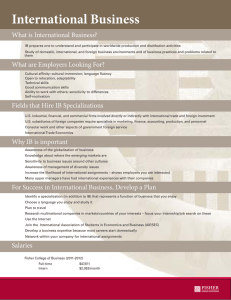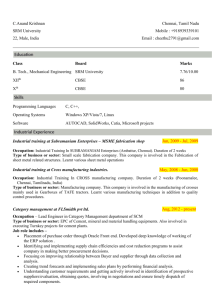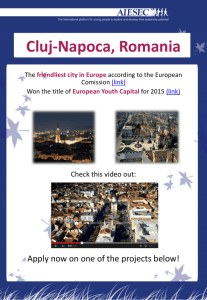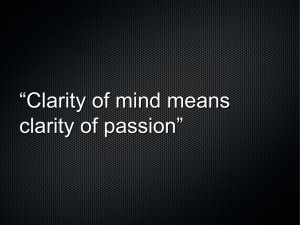AIESEC Strategic Approach Applicable to Innovative SMES of Guadalajara
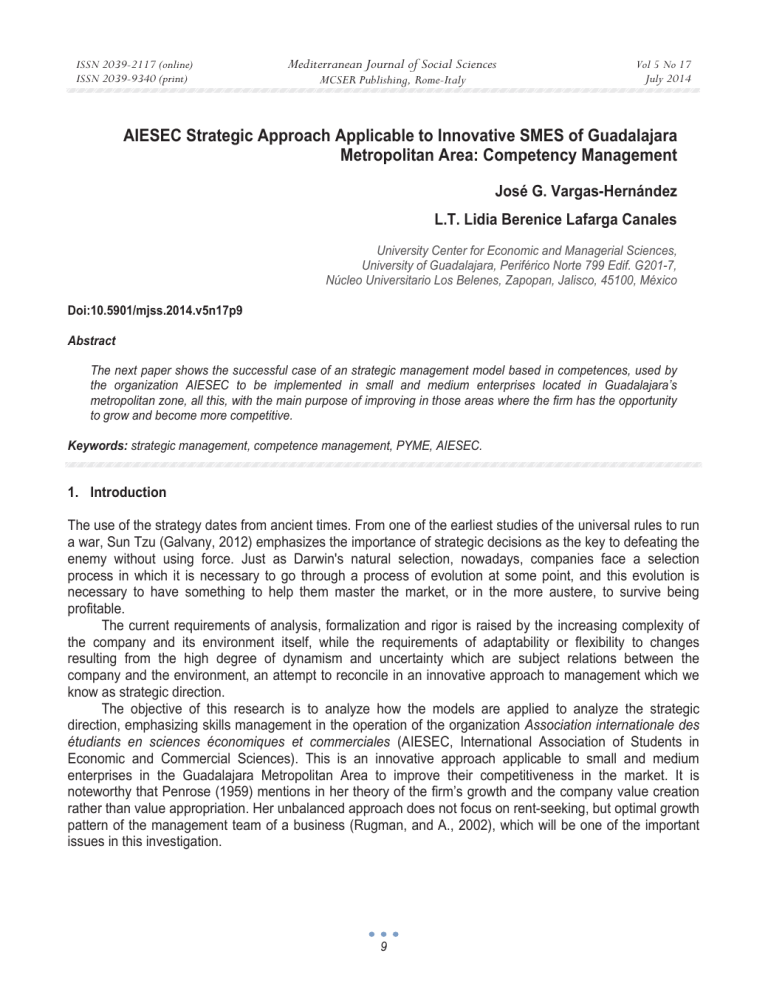
ISSN 2039-2117 (online)
ISSN 2039-9340 (print)
Mediterranean Journal of Social Sciences
MCSER Publishing, Rome-Italy
Vol 5 No 17
July 2014
AIESEC Strategic Approach Applicable to Innovative SMES of Guadalajara
Metropolitan Area: Competency Management
José G. Vargas-Hernández
L.T. Lidia Berenice Lafarga Canales
University Center for Economic and Managerial Sciences,
University of Guadalajara, Periférico Norte 799 Edif. G201-7,
Núcleo Universitario Los Belenes, Zapopan, Jalisco, 45100, México
Doi:10.5901/mjss.2014.v5n17p9
Abstract
The next paper shows the successful case of an strategic management model based in competences, used by the organization AIESEC to be implemented in small and medium enterprises located in Guadalajara’s metropolitan zone, all this, with the main purpose of improving in those areas where the firm has the opportunity to grow and become more competitive.
Keywords: strategic management, competence management, PYME, AIESEC.
1.
Introduction
The use of the strategy dates from ancient times. From one of the earliest studies of the universal rules to run a war, Sun Tzu (Galvany, 2012) emphasizes the importance of strategic decisions as the key to defeating the enemy without using force. Just as Darwin's natural selection, nowadays, companies face a selection process in which it is necessary to go through a process of evolution at some point, and this evolution is necessary to have something to help them master the market, or in the more austere, to survive being profitable.
The current requirements of analysis, formalization and rigor is raised by the increasing complexity of the company and its environment itself, while the requirements of adaptability or flexibility to changes resulting from the high degree of dynamism and uncertainty which are subject relations between the company and the environment, an attempt to reconcile in an innovative approach to management which we know as strategic direction.
The objective of this research is to analyze how the models are applied to analyze the strategic direction, emphasizing skills management in the operation of the organization Association internationale des
étudiants en sciences économiques et commerciales (AIESEC, International Association of Students in
Economic and Commercial Sciences). This is an innovative approach applicable to small and medium enterprises in the Guadalajara Metropolitan Area to improve their competitiveness in the market. It is noteworthy that Penrose (1959) mentions in her theory of the firm’s growth and the company value creation rather than value appropriation. Her unbalanced approach does not focus on rent-seeking, but optimal growth pattern of the management team of a business (Rugman, and A., 2002), which will be one of the important issues in this investigation.
9
ISSN 2039-2117 (online)
ISSN 2039-9340 (print)
Mediterranean Journal of Social Sciences
MCSER Publishing, Rome-Italy
Vol 5 No 17
July 2014
2.
Background
Over the years it has gone from an economic revolution to another. These "revolutions" are based on trends in emerging markets or sudden drastic changes in the conditions under which it performs the processes of production, distribution and / or consumption of goods and services. Many authors agree that we have a new economic model based on knowledge (Moreno, Pelayo and Vargas 2004), i.e. today, unlike what happened in the agricultural age or industrial age in the current knowledge era. Thus, this looms as the main element of survival and competitiveness for a company, so they are being forced to promote this intangible in order to remain in uncertain environments and increasingly complex due to the accelerated speed that technology and knowledge change (Ronda y Marcané, 2004).
A Human Resource Management competency-based (or skills) addresses comprehensively the strategic dimension of business, the human dimension and the behavioral (Mamolar, 2001a, p.21). In order to maintain this constant flow of updated information, it is certainly necessary to carry out a series of activities that help to create, share and implement this knowledge in their respective companies. Given the above, the executive now has realized that certainly for the existence of this process is required the staff intervention of the firm. It has started giving more importance to the human capital of the company as a key, which is acquiring a strategic differential value and great importance for the growth and development of the company itself (Guerras y Navas, 2008).
About three-quarters of employers globally have lack of experience, ability or knowledge as the main cause which creates difficulties in filling positions in any firm. Despite the uneven and slow recovery that has been following the economic recession that hit the world and existing high unemployment in many markets, in international organizations still show disagreements with no access to talent their firms need in a timely manner (Nelson, Winter, S. 1982)..
Returning to the "Penrose effect" (Rugman and A., 2002), indicates the limits to the growth rate of the company, due to the limitations of management, and the importance of the elements of behavior and learning processes growth thereof. Her views on the growth process are noteworthy, especially the enactment of the environment and the discovery of productive opportunities through a dynamic learning process.
It is for this reason that it has been decided to take a strategic management approach based on knowledge management taken by the international organization AIESEC. AIESEC is a youth organization founded in 1948 in Europe, non-profit, fully managed by young, independent, apolitical and nondiscriminatory. Since 1922, AIESEC credited UNESCO as "World Youth Voice". Originally named for
"International Association of Economic and Commercial Sciences", by its French acronym, today, AIESEC covers different careers and areas of study, so that AIESEC is used as a proper name and not an acronym
(AIESEC Internacional, 2011a).
AIESEC is the largest student organization in the world, present in more than 113 countries. It is focused on providing a platform conducive to leadership development and provides young people the opportunity to participate in international practice, experience leadership and participate in a global learning environment. It also worked with more than 4,000 companies and organizations in 113 countries, who prefer
AIESEC candidates for the added value they can provide (AIESEC International, 2011a, 2011b).
Departing from this, after Mexico City, Jalisco is the second place with the highest concentrations of small and medium enterprises (SMEs) in the country. More however, one of the major problems facing the
SMEs is not having the culture to provide a continuous learning environment for human capital, generating that this competitive advantage must be affected in a market in constant motion. Because of this situation, the case of AIESEC is taken as an object of study that allows highlighting the good strategic management model implemented by the organization itself. This model can be applied to small and medium enterprises in the (Guadalajara Metropolitan Area) GMA that certainly have potential for obtained an increased competitive advantage by giving their addresses a management approach by competencies.
The Secretary for Small and Medium Enterprises of the Ministry of Economy announced in June of this
10
ISSN 2039-2117 (online)
ISSN 2039-9340 (print)
Mediterranean Journal of Social Sciences
MCSER Publishing, Rome-Italy
Vol 5 No 17
July 2014 year, delivering a fund of 100 million pesos to support small and Medium Enterprises in the state of Jalisco.
This announcement highlighted the need to support entrepreneurs not only with funding but also with training and technical assistance (Ministry of economy 2013). Enhancing the above mentioned, is the focus on human capital for growth and consolidation of the firm. The importance of these governmental programs to support SMEs in the GMA (GMA-SMEs) is that micro, small and medium enterprises nationwide are representing 98 percent of economic units in the country. Therefore, it is necessary to generate strategic support schemes (SE 2013).
It was not until 1985 that the Ministry of Commerce and Industrial Development (SECOFI), now Ministry of Economy, officially established the criteria for classifying industries according to their size and this is how it is currently sorting under the following strata (INEGI 2011): a.
Microindustry. Companies that occupy up to 15 people and net sales value is up to 30 million pesos a year. b.
Small industry. Companies that occupy up to 100 people and net sales remained within the amount of 400 million pesos a year. c.
Medium industry. Companies that occupy up to 250 people and the value of its sales did not exceed the amount of one thousand 100 million pesos a year.
From this, the course of this research focuses only on small and medium enterprises.
3.
Problem Delimitation
Given the issues discussed above, is that it comes to the question: How to improve the competitiveness of
SMEs in the metropolitan area of Guadalajara, applying the innovative model used by AIESEC strategic management with a focus on management skills?
This question will help to channel the good decisions made by the organization AIESEC in its strategic management, toward areas of opportunity for the SMEs in the ZMG. Thus, this strategy aims to counter the decline existing in knowledge and training regarding human capital, and focusing efforts on management by competency that will lead to improve competitiveness in the market.
4.
Assumption
Arriving with the above to a theoretical assumption in the following terms: AIESEC has a strategic management based on competency management that can be implemented by SMEs in the Guadalajara metropolitan area in order to improve their competitiveness in the market orientation, emphasizing the importance of ongoing training and investment in updating of knowledge for human capital within your company.
5.
Contextual Framework
As it was mentioned above, AIESEC is the worldwide largest international youth organization. It is present in over 113 countries and in the Mexican republic it has local committees distributed as follows in figure 1 below.
According to INEGI (2011) the 7.18% of MSMEs are in Jalisco. These economic units are distributed mainly in the fields of manufacturing, trade and services. At national level, Jalisco´s MSMEs that have greater weight in Mexico are small and medium manufacturing in 2003, representing 13.21% and 9.69% respectively.
Besides manufacturing, small businesses happens to be also of some national importance (9.08%). This pattern reflects a traditional economic vocation to these trade and manufacturing sectors.
11
ISSN 2039-2117 (online)
ISSN 2039-9340 (print)
Mediterranean Journal of Social Sciences
MCSER Publishing, Rome-Italy
Figure 1: AIESEC México´s local entities.
Vol 5 No 17
July 2014
Source: AIESEC Internacional (2011a, 2011b).
Besides the above, it was also found that one of the most worrisome problems in this industry is that 31% have trouble finding qualified personnel. It is because of this that it is taken these two items: Strategy approach to competence management AIESEC and the SME in the GMA. This research report is concerning the strategic management of SMEs in the GMA (GMA-SMEs).
6.
Method of study
To make the development of this research, it was made purely qualitative approach; although it was used statistical data that have helped us to visualize the current status of state economic units and their importance while most was only made with intend to have a frame of reference for the dimensions in which we are working. This is because the qualitative approach will help to see the objective reality of the study problem. It is not intended in this case, to measure in which way this strategic management approach is affecting this type of competency-based economic units in question.
7.
Theoretical Framework
The theories considered s a precedent for the development of the same investigation are the resource-based theory and the theory of capabilities and transaction costs. These theories help to understand how the SMEs-
AIESEC strategy can capitalize on the capabilities of human capital and how it is important to have corporate governance interested in the capacity building of its staff rather than on their own gains and benefits.
It has been included the theory of transaction costs, as mentioned by Mahoney (2005). The human information processing limitations are further compounded by the potential for deliberate non-disclosure information, deliberated obfuscation, and performing statements that are not self-believed, all of them as forms of opportunism. These behaviors are very marked in economic units such as SMEs given to the profiles that are regularly driving on management and general levels of human capital, that, given the prevailing trend in the composition of small businesses starting from a family structure, for example.
The firm is then seen as a mechanism to account for bounded rationality, but also to mitigate opportunistic behavior.
8.
Development of the Assumption
AIESEC is working on four different levels of hierarchy. It has an international committee based in the city of
12
ISSN 2039-2117 (online)
ISSN 2039-9340 (print)
Mediterranean Journal of Social Sciences
MCSER Publishing, Rome-Italy
Vol 5 No 17
July 2014
Rotterdam, which handles scenarios of a general nature and international, committees by region (Asia, Latin
...), national committees and finally a stepping stone to the local level, which can be focused to a specific college or cities. This research focuses the analysis on the local committee of AIESEC in Guadalajara, its organizational structure and strategic direction.
AIESEC has the following areas where youth can develop leadership skills to carry out all the necessary processes that are necessary for the organization and specifically to fulfill the goals of the local committee:
Figure 2: Structure of local committee in Guadalajara.
Source: Own elaboration based on data from AIESEC Internacional (2011a, 2011b)
In any of the above levels, AIESEC aims to always create change agents who can develop the skills that are an essential part of its strategic management, which are according to AIESEC International (2011a, 2011b) the following shown on figure 3 below.
Figure 3: Competencies in AIESEC
Source: AIESEC Internacional (2011a, 2011b).
13
ISSN 2039-2117 (online)
ISSN 2039-9340 (print)
Mediterranean Journal of Social Sciences
MCSER Publishing, Rome-Italy
Vol 5 No 17
July 2014
8.1
Global mindset
Fostering diversity, openness and respect for different cultures, working effectively with people from different countries than have a culture other than their own, with different lifestyles and skills, making appropriate use of the ideas and views to the achievement of goals.
8.2
Business outlook
Develop and implement new ideas, organize and manage resources and opportunities, while engaging influence other people, and increase performance by taking risks and adopting innovative solutions to problems that come to inspire.
8.3
Social responsibility:
Focusing to give a balanced picture of economy, social welfare and ecological balance, also, worrying about the results not only short term but considering the possible future scenarios for the actions taken.
8.4
Emotional intelligence
That refers to direct the emotions and balance them, having the capacity to understand, feel, modify and control their own moods and others.
8.5
Proactive learning
Being in continuous improvement, both personally and professionally while also improving the knowledge and skills of others trying different learning methods.
These five competencies outlined above, not only are important to develop for an organization such as
AIESEC, but according to the current problem of the lack of sufficiently qualified human capital to manage
SMEs in the Guadalajara metropolitan area. AIESEC has an option highly competitive for process improvement in a continuous and constant updating of knowledge in the firm.
Now, for an individual within AIESEC can generate these skills and develop a strategic role within the same organization, it has a global learning system, which for the purposes of this analysis is the core of this research, as through various learning environments is that it achieves a management strategy based on competency management used in an innovative way to what has been implemented regularly by micro entrepreneurs.
According to information retrieved from the Ministry of Economy, it can be seen that the biggest problems faced by entrepreneurs to start a micro, small or medium business, are as follows (PROMEXICO
2013) a.
No profits are reinvested to improve equipment and production techniques. b.
It's difficult to recruit skilled and trained staff for inability to pay competitive salaries. c.
The production quality has some shortcomings because quality controls are minimal or nonexistent. d.
They cannot absorb the costs of staff training and updating, but when they do, they face the problem of leakage of trained personnel. e.
Some other problems arising from the lack of organization.
From these problems it can be possible to salvage for the purposes of the research, that there are at least two points of which to give the firm a turn based on competency management. Using a model like the one used currently by AIESEC, will reduce, if not eradicate such problems as the difficulties to recruit trained personnel and the leak once having invested in it. Counting then economic structures of small and medium
14
ISSN 2039-2117 (online)
ISSN 2039-9340 (print)
Mediterranean Journal of Social Sciences
MCSER Publishing, Rome-Italy
Vol 5 No 17
July 2014 enterprises in the Guadalajara metropolitan area, it is possible to analyze how these learning environments work for such firms.
It is noteworthy that in the interesting case of AIESEC, it is found a global network of young students and recent graduates who are working even standard hours of working days (in some cases) for a cause that does not generate any profit. Thus, a comparison of this type of model can be implemented for SMEs located in the aforementioned area of Guadalajara, where the financial remuneration is low or even occasionally also limited. Then it is referred to global learning environments of AIESEC and how come a focus on SMEs in the
ZMG according to the problems discussed above.
AIESEC offers a unique global learning environment that helps the membership of its committees to develop and enhance their leadership skills among other skills. Such environments are ranging from online discussions, virtual experiences teamwork, coaching key executives, among others as shown in figure 4.
Figure 4.
Global learning environment. (AIESEC International, 2011a, 2011b)
A.
Individual discovery
The working staff provides tools to gain a better understanding of what they can achieve on their own, it will increase their performance at work, and increasing self-esteem will be the same, thus raising their level of satisfaction and loyalty to their job.
B.
Team experiences
The teams are based on the organizational structure of AIESEC, which allows them to have relevant planning which assist the achievement of goals or objectives, within a specified period of time and constant evaluation and recognition of success.
Peng (2006) mentions in his book "Global Strategy", that there is a board of directors that oversees as an intermediary between owners and managers, ratifies strategic decisions and evaluates, rewards, and if necessary penalize senior managers. The main features of the board are its composition, leadership structure and interlocks. It is very important that each of the members of the firm, however small is that economic unit, he or she feels part of a team, and to know that his/her work contributes to a goal and that work will be recognized. The members of the board will remunerated such recognition with loyalty to their company and join efforts to achieve the objectives. It will be as it might said colloquially, t “to wear the shirt of the team" and have a sense of belonging that will be reflected in results.
C.
Mentoring
AIESEC handles mentoring in the following terms in this field:
Mentoring relationships provide an important source of external feedback - With other members and allies of AIESEC - About the decisions inside and outside AIESEC. We create friendly relations between our stakeholders and powerful networks (AIESEC International 2011a, 2011b).
In this case, mentoring could have implications for the GMA-SMEs preparedness projects and technological support, not just financial, offered by the state government periodically and that many entrepreneurs are not aware of it (Secretaría de Economía, 2013a, 2013b).
Even cooperation programs, as Innocámaras , a program whose main objective is to contribute to improving the competitiveness of SMEs in the province by integrating the culture of innovation in their business strategies) handled by the Chamber of Commerce of the State of Jalisco. On this program, successful business entrepreneurs are giving support to those through direct coaching or training for better resource management. It is considered as an option that facilitates the
15
ISSN 2039-2117 (online)
ISSN 2039-9340 (print)
Mediterranean Journal of Social Sciences
MCSER Publishing, Rome-Italy
Vol 5 No 17
July 2014 development of new ideas without having to make mistakes like anyone else has already done
(Cámara de Comercio, 2013).
D.
Virtual Spaces
The technology certainly is a fundamental part of the business world today. AIESEC has a global virtual platform (myaiesec.net) which is a unique platform of resources, contact information, forums, news, classifieds and constant promotion of exchange and leadership opportunities, locally, nationally and internationally. Likewise also have major Internet channels such as YouTube, Flickr, and Facebook to stay connected to your AIESEC friends in all parts of the world.
No doubt, for a company to be competitive today, it is necessary to kept up to date and following the competitive world trends. This is why it is advisable for SMEs ZMG that has one or more of the above resources mentioned to be given a "plus" to their daily activities, thus achieving not only be informed, but likewise it helps the positioning and growth of business.
E.
Conferences and seminars
These conferences and seminars support the activity of the organization. They become re-planning or restructuring periods, raises new strategies, share ideas and discuss issues that are likely to affect the performance or achievement of organizational objectives. In addition, the conferences and seminars help to raising the level of motivation and empathy for the values of the organization.
F.
Learning circles:
Finally, within AIESEC learning circles features, which are communities aimed to discuss and share information on topics that are common to all members, partners or sponsors. These learning circles, both virtual and physical, are formed by AIESEC members who have a common interest to gain experience, knowledge and networks in a sector or common theme.
If adopted the latter as an SME strategy for personal and professional growth of personnel and staff, it would be in a work environment that will foster ongoing collaborative potential growth for the company in question.
9.
Results
The assumption raised at the beginning of the paper, is found by noting that AIESEC has a strategic management based on competency management in global learning environment. These principles of strategic management can be implemented by SMEs in the Guadalajara metropolitan area in order to improve their level of competitiveness in the market orientation, emphasizing the importance of ongoing training and investment in the upgrade of knowledge for human capital within your company as was discussed above.
10.
Conclusions
There are areas of opportunity in the GMA-SMEs that can be covered by management strategies based on skills, implemented by AIESEC in order to make the same more competitive in today's market.
There were detected as well as programs with little diffusion to support the growth of these economic units in the metropolitan area of Guadalajara.
One ZMG-SMEs has the opportunity to be more competitive by implementing successful management models based on competencies that do not generate high costs for their business unit and simultaneously drive the development and growth of the same at high levels.
16
ISSN 2039-2117 (online)
ISSN 2039-9340 (print)
Mediterranean Journal of Social Sciences
MCSER Publishing, Rome-Italy
Vol 5 No 17
July 2014
References
AIESEC Internacional (2011a). Ambientes globales de aprendizaje.
Recuperado de: http://www2.aiesec.org/cms/aiesec
/AI/Iberoamerica/southern%20cone%20-%20chile/aiesec%20concepcion/estudiantes/Ambientes_de_aprendizaje
_global.html
AIESEC Internacional (2011b). ¿Qué competencias desarrollas en AIESEC?.
Recuperado de: http://www2.aiesec.org
/cms/aiesec/ai/iberoamerica/colombia/aiesec%20ean/inicio/aiesec_gcm.html
Cámara de Comercio (2013). Ayuda de cámara de comercio para que las pymes sean más competitivas.
Recuperado de: http://www.camaraguadalajara.org/
Galvany, A. (2012b). Sunzi. El arte de la guerra. Traducción directa del chino antiguo . Madrid: Trotta. 8° edición.
Guerras, L. y Navas, J. (2008). Casos de dirección estratégica de la empresa . Madrid, España. Thompson. 4° edición.
INEGI (2011). Micro, pequeña, mediana y gran empresa: estratificación de los establecimientos . Censos Económicos
2009. Instituto Nacional de Estadística y Geografía. México : INEGI.
Mahoney, J. T. (2005). The theoretical building blocks of organizational economics . Economic foundations of strategy,
299-304.
Mamolar, P. (2001). Las competencias desde la perspectiva de los individuos (I). Capital Humano . nº 149, págs. 21.
Moreno, J.; Pelayo, Y. and Vargas, A. (2004). La gestión por competencias como herramienta para la dirección estratégica de los recursos humanos en la sociedad del conocimiento .
Revista de empresa . España.
Nelson, R. R.; Winter, S. (1982). An Evolutionary Theory of Economic Change , Cambridge, MA Harvard University Press.
Peng, Mike W. (2006). Governing the Corporation Around the World . Global strategy. Cengage Learning. 320:345.
Penrose, E T. (1959). The theory of the growth of the firm . New York, Oxfod University Press.
Ronda, G. y Marcané, J. (2004). De la estrategia a la dirección estratégica. Modelo de dirección estratégica Integrada.
Acercamiento a la complementación de los niveles estratégico, táctico y operativo. Primera parte.
Ciencias de la
Información Vol. 35, No. 1
Rugman, A. and A. V. (2002). Edith Penrose’s contribution to the resource-based view of strategic management.
Strategic Management Journal , 23: 769-780.
Secretaría de economía (2013a). Apoyará se desarrollo de pymes de Jalisco con 100 mdp.
Recuperado de: http://www.economia.gob.mx/eventos-noticias/sala-de-prensa/comunicados/6383-apoyara-se-desarrollo-depymes-de-jalisco-con-100-mdp
Secretaría de economía (2013b). PyMES, eslabón fundamental para el crecimiento en México.
Recuperado de: http://www.promexico.gob.mx/negocios-internacionales/pymes-eslabon-fundamental-para-el-crecimiento-enmexico.html
17
ISSN 2039-2117 (online)
ISSN 2039-9340 (print)
Mediterranean Journal of Social Sciences
MCSER Publishing, Rome-Italy
Vol 5 No 17
July 2014
18
